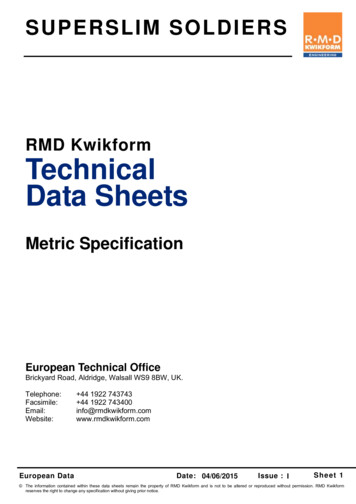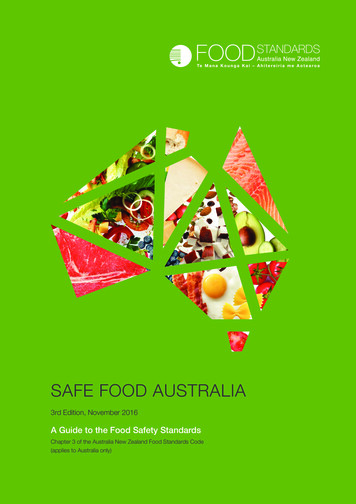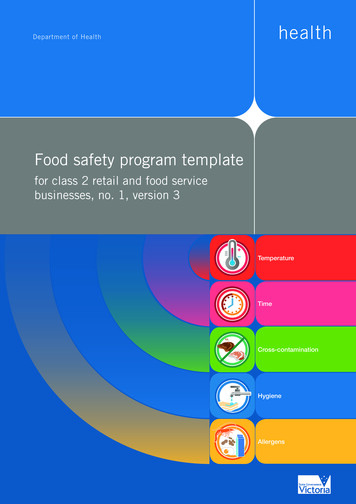
Transcription
AUG 9 - Z005Summary of Safety and EffectivenessThis summary of 510(k) safety and effectiveness information is being submitted inaccordance with the requirements of SMDA 1990 and 21 CFR 807.92.The assigned 510(k) number is: K043224GEN-PROBE APTIMA COMBO2 AssayGEN-PROBE APTIMA Specimen Transfer KitSponsor/Contact InformationSubmitted By:Gen-Probe Incorporated10210 Genetic Center DriveSan Diego, California 92121Phone: (858) 410-8000Company Contact:Alan Maderazo, Ph.D., RACSr. Regulatory Affairs SpecialistPhone: (858) 410-8332Fax: (858) 410-8139e-mail: alanma gen-probe.comGen-Probe IncorporatedConfidentialPage 1 of 16
General InformationTrade Name:GEN-PROBE APTIMA COMBO2 AssayCommon or Usual Name:Ribosomal RNA (rRNA) target-amplified nucleic acid probetest for the in vitro diagnostic detection of Chlamydiatrachomatis and/or NeisseriagonorrhoeaeClassification Names:DNA Probe, Nucleic Acid Amplification, ChlamydiaDNA Reagents, NeisseriaAPTIMA Combo 2 AssayDevice DescriptionMedical SpecialtyProduct CodeDevice ClassRegulation numberDNA Probe, Nucleic Acid Amplification, ChlamydiaMicrobiologyMKZI866.3120Device DescriptionMedical SpecialtyProduct CodeDevice ClassRegulation numberDNA Reagents, NeisseriaMicrobiologyLSL2866.3390Substantially Equivalent Devices:APTIMA Combo 2 Assay (K003395)Roche COBAS AMPLICORTM CT/NG Test(P950039/S008)Gen-Probe IncorporatedConfidentialPage 2 of 16
Device DescriptionClearance of this premarket notification extends the clinical performance claims of thecommercially available GEN-PROBE APTIMA Combo 2 Assay to include PreservCytliquid Pap specimens (collected and processed by the Cytyc ThinPrep 2000 Processor) asacceptable testing specimens. The ancillary kit formulated for this specific application isthe GEN-PROBE APTIMA Specimen Transfer Kit. The components of the APTIMASpecimen Transfer Kit include: (1) a transport tube containing transport media with apenetrable cap and (2) specific instructions for use regarding decontamination andspecimen processing procedures. The APTIMA Specimen Transfer Kit may only be usedin conjunction with GEN-PROBE APTIMA Assays for the detection of Chlamydiatrachomatisand/or Neisseria gonorrhoeae.Gen-Probe IncorporatedConfidentialPage 3 of 16
Intended UseAC2 Assay package insert:The APTIMA Combo 2 Assay is a target amplification nucleic acid probe test that utilizestarget capture for the in vitro qualitative detection and differentiation of ribosomal RNA(rRNA) from Chlamydia trachomatis (CT) and/or Neisseria gonorrhoeae (GC) inclinician-collected endocervical, vaginal, and male urethral swab specimens, patientcollected vaginal swab specimens*, and female and male urine specimens. The assay isalso intended for use with testing of gynecological specimens collected in the PreservCytSolution and processed with the Cytyc ThinPrep 2000 System. The assay may be used totest specimens from symptomatic and asymptomatic individuals to aid in the diagnosis ofgonococcal and/or chlamydial urogenital disease.*Patient-collected vaginal swab specimens are an option for screening women when apelvic exam is not otherwise indicated. The vaginal swab specimen collection kit is not forhome use.Ancillary Kit package insert:The GEN-PROBE' APTIMA Specimen Transfer Kit is only for use with GEN-PROBEAPTIMA assays for the detection of Chlamydia trachomatis and/or Neisseriagonorrhoeae. The GEN-PROBE APTIMA Specimen Transfer Kit allows for APTIMAAssay testing of gynecological specimens collected and processed by the Cytyc ThinPrep2000 Processor according to the instructions provided.Gen-Probe IncorporatedConfidentialPage 4 of 16
APTIMA Combo 2 AssayA complete description of the APTIMA Combo 2 Assay is provided in the commercializedpackage insert.Summary of Non-Clinical (Analytical Laboratory) Performance DataLimit of Detection (Analytical Sensitivity)Chlamydia trachomatis analytical sensitivity (limits of detection) was determined bydirectly comparing dilutions of C. trachomatis organisms in cell culture and in the assay.The analytical sensitivity claim for the assay is one Inclusion-Forming Unit (IFU) perassay (9.75 IFU/mL PreservCyt liquid Pap) for all 15 C. trachomatis serovars. However,dilutions of less than 1 IFU/assay of all serovars tested positive in the APTIMA Combo 2Assay.Neisseria gonorrhoeae analytical sensitivity was determined by directly comparingdilutions of 20 different clinical isolates in culture and in the APTIMA Combo 2 Assay.The analytical sensitivity claim for the assay is 50 cells/assay (488 cells/mL PreservCytliquid Pap). However, all strains tested were positive at less than 50 cells/assay.Analytical SpecificityThe Chlamydia and Neisseria species were used to evaluate the analytical specificity of theAC2 Assay. A total of 50 culture isolates were tested in the PreservCyt liquid Pap media.These isolates included 47 Neisseria strains and two species of Chlamydia (two strains ofChlamydia psittaci and one strain of Chlamydia pneumoniae). All organisms except C.psittaci and C. pneuomoniae were tested at greater than 1.0 X 106 cells/assay in the mixedsolution (PreservCyt/STM).concentration of 7.91x 10 4For C. psittaci, two isolates were tested-VR601 at acells/assay, and VR629 at a concentration of Ix104CELD 50 /0.2 mL. For C. pneumoniae (VR1360), the tested concentration was 3.95 x 103Gen-Probe IncorporatedConfidentialPage. of16
cells/assay. The list of organisms tested and their corresponding AC2 Assay results areprovided in the Table belowAnalytical Specificity - PreservCyt liquid Pap Specimen StudyORGANISMORGANISMChlamydiapsittaciChlamydia psittaciChlamydia pneumoniaeNeisseria elongate (3)NLeisseria favaNeisseria mucosaNeisseria mucosaNeisseria perfiavaNeisseria siccaNeisseria siccaNe isseria sub,tiava(1 4)Neisseria cinerea (4)Neisseria dentrificansNeisseria lactamica (9)A meningitidis SerogroupN. meningitidis SerogroupN. meningitidis SerogroupN. meningitidis SerogroupN. meningitidis SerogroupN meningitidis SerogroupNeisseriapolysacchareaABC (4)DYW135(n) number of strains testedAll organisms tested produced a negative result in the APTIMA Combo 2 Assay.Interference StudiesThe following substances commonly present in cervical specimens that were tested in theassay. 10% blood, contraceptive jelly, spermicide, moisturizer, hemorrhoidal anesthetic,body oil, powder, anti-fungal cream, vaginal lubricants, feminine spray, and leukocytes (1X 106cells/mL).All were tested for potential assay interference in the absence and presence of C.trachomatis and N. gonorrhoeae at the estimated rRNA equivalent of one C. trachomatisIFU/assay (5 fg/assay) and 50 N. gonorrhoeae cell/assay (250 fg/assay). The rRNAequivalents were calculated based on the genome size and estimated DNA:RNA ratio/cellof each organism. No interference was observed with any of the tested substances.RecoveryGen-Probe IncorporatedConfidentialPage 6 of 16
Escherichia coli,Gardnerella vaginalis, Lactobacillus acidophilus, Bacteroidesureolyticus and Staphylococcus epidermidis (I x 108 cells/assay) were added to samplescontaining the rRNA equivalent of approximately I C. trachomatis IFU (5 fg) and 50 N.gonorrhoeae cells (250 fg). These additions did not interfere with the amplification anddetection of C. trachomatisor N. gonorrhoeaerRNA using the AC2 Assay.PreservCyt Liquid Pap Specimen Stability StudiesData to support the recommended shipping and storage conditions for PreservCyt liquidPap samples were generated with pooled negative PreservCyt liquid Pap samples. Fourpooled samples were spiked with C. trachomatis and N. gonorrhoeae at finalconcentrations of 10 IFU and 100 CFU per reaction, respectively. The PreservCyt liquidPap samples were placed at 30 C for 7 days, after which I mL of the sample was added to0an APTIMA Transfer Tube. The spiked samples were held at 40C, 10 C and 30 C. Samplesstored at 4 C and 100C were tested in duplicate at days 0, 6, 13, 26, 30 and 36. Samplesstored at 30 C were tested in duplicate at days 0, 5, 8, 14 and 17. Four spiked PreservCytliquid Pap sample pools were added to APTIMA Transfer Tubes and placed at 30 C for 14days before being stored at -200C. The -20 C samples were tested in duplicate after 0, 30,60, 90 and 106 days of storage. All test conditions were positive for both C. trachomatisand N. gonorrhoeae at all times and temperatures.PrecisionReproducibility was established with a 12-member panel generated by spiking PreservCytSolution with 0 to 2000 fg/assay of C. trachomatis and 0 to 5,000 fg/assay of N.gonorrhoeae rRNA and aliquotting lmL into the APTIMA Specimen Transfer Kitcollection tube. Two (2) operators at each of the three sites performed one run per day oneach of three days, totaling three valid runs per operator. The results of the precision studyare summarized in the table below. Reproducibility when testing PreservCyt liquid Papclinical specimens containing target organism has not been determined.Gen-Probe IncorporatedConfidentialPage 7of16
-MC NC) 00 40044 C/CCo -Co()(Niiw00)00O) 0N(LONXcoCO'TCoW.N00W00-0 0o.N.n.N.c.tm0I00-COC).z. 0)(0N00* C WGCOC-IWWtImCI0t000-o- Inv00m0000" o00NN0tLOM0X-000I 00w0) 0-ICN-C"Z00.- w0 I*0)C\]a)00CO 0)W)00J00 COH.- C0C000C 00(N--CElOD11-JIDCD)IWN(44m0In I4C- .2Cr44 00 .C) a00.00D .W0* 0 .CO0 0) 040)-C\I --ItCWNCr.' E
PreservCyt Liquid Pap Specimen Clinical Study ResultsA prospective multi-center clinical study was conducted to evaluate the use of thePreservCyt Solution (a component of the ThinPrep 2000 System) as an alternative mediumfor gynecological specimens for the detection of Chiamlydia trachomatis and Neisseriagonorrhoeae. One thousand six hundred forty-seven (1,647) symptomatic andasymptomatic female subjects attending OB/GYN, family planning, public health,women's and STD clinics were evaluated in the clinical study. Of the 1,647 evaluablesubjects, 1,288 were asymptomatic subjects and 359 were symptomatic subjects. Subjectswere enrolled from sites with CT prevalence that ranged from 3.2 to 14.0% and GCprevalence that ranged from 0 to 5.0%. Two specimens were collected from each eligiblesubject: one PreservCyt Solution specimen and one endocervical swab. PreservCytSolution specimens were processed in accordance with the ThinPrep 2000 ProcessorOperator's Manual and APTIMA Specimen Transfer Kit Package Insert. After processingthe PreservCyt Solution specimen with the ThinPrep 2000 Processor, the specimen wastransferred into the APTIMA Specimen Transfer Kit for testing with the APTIMA Combo2 Assay. The PreservCyt liquid Pap specimens and endocervical swab specimens weretested with the APTIMA Combo 2 Assay.Sensitivity and specificity for PreservCyt liquid Pap specimens were calculated bycomparing results to a patient infected status algorithm. In the algorithm, the designation ofa subject as being infected or non-infected with C. trachomatis or N gonorrhoeae wasbased on endocervical swab specimen results from two commercially-available NAATs.For C. trachomatis, the reference NAATs included the APTIMA Combo 2 Assay and theAPTIMA CT Assay. For N. gonorrhoeae, the reference NAATs included the APTIMACombo 2 Assay and the APTIMA GC Assay. Positive results from both reference NAATswere required to establish an infected patient. A non-infected patient was established if theresults from the two reference NAATs disagreed or were negative.Sensitivity and specificity for C. trachomatis in PreservCyt liquid Pap specimens tested inthe APTIMA Combo 2 Assay, by symptom status and overall, is presented in Table 1. ForGen-Probe IncorporatedConfidentialPage 9 of 16
C. trachomatis, overall sensitivity was 96.7% (87/90). In symptomatic and asymptomaticOverallsubjects, sensitivity was 96.7% (29/30) and 96.7% (58/60), respectively.specificity for C. trachomatis PreservCyt liquid Pap specimens was 99.2% (1545/1557).In symptomatic and asymptomatic subjects, specificity was 98.5% (324/329) and 99.4%(1221/1228), respectively. Table 2 shows the APTIMA Combo 2 Assay sensitivity andspecificity values for C. trachomatis in PreservCyt liquid Pap specimens by clinical siteand overall. For C. trachomatis, the sensitivity ranged from 92.9% to 100%. Thespecificity ranged from 97.7% to 100%.Sensitivity and specificity for N. gonorrhoeae in PreservCyt liquid Pap specimens tested inthe APTIMA Combo 2 Assay, by symptom status and overall, is presented in Table 3. ForN. gonorrhoeae, overall sensitivity was 92.3% (12/13). In symptomatic and asymptomaticsubjects, sensitivity was 100% (7/7) and 83.3% (5/6), respectively. Overall specificity forN. gonorrhoeae PreservCyt liquid Pap specimens was 99.8% (1630/1633).Insymptomatic and asymptomatic subjects, specificity was 100% (352/352) and 99.8%(1278/1281), respectively. Table 4 shows the APTIMA Combo 2 Assay sensitivity andspecificity values for N. gonorrhoeae in PreservCyt liquid Pap specimens by clinical siteand overall. For N. gonorrhoeae, the sensitivity ranged from 80.0% to 100%. Specificityranged from 99.0% to 100%.The distribution of cervical sampling devices used in this clinical study according toclinical site is summarized in the table below.Cervical sampling devicesCollection SiteCervical sampling deiciselSpatula/CytobrushBroom-Type Probe IncorporatedConfidentialPage 10 of 16
06 'o 5 i0., 4-, 0 0-ON00nON c ONOCA ?5 Z00Z ON ON 1ON0'r3 ONrON
0z CCU,ChrON0-ONONtU,NenON 00N1ttNNi,000NNNN00hr0 C-NCtCC'0C0-LO02002000c-ien0)0)-E 2C.2Ct02 -r0-cii u.n0020t00000tCenyNen Cr-Nenlit0
nciaenenaCaettCaEutn0en'CNCa enmen----Ct -a)a)I--I-dCa'I-U0'CN0000Itt'C) '-'C)c1c1-2-Cd,LU -,t4 ta U00Uocr 000000a InInIn. .Cla)U-C)Ct4-C) C) C)C)C) C) C) .-at0-0)'II-Oa)0Ca-Clrir-UUQQQQC)0
ON-I2In00CCrL00C0C0!-Z 4)0)00tIN- 0U0004010000mm000000riOKCrC00InInC)-000CC)OOC. .- -e0000000OQOtIn'0000t0000r]OQIn0In 22. 4)OI-o;Q4)Cr4)'.-,4)4)F-.-e0)4)4)'½4)4)4) '- ¶Z0O-4)00C)CrCroO 4)4)o4)O0-ZH-Z--otoZH4)QoZ-0ririQU4) '114)tCr-Cl0
PrevalenceThe prevalence of C. trachomatis and/or AN.gonorrhoeae disease in patient populationsdepends on risk factors such as age, gender, the presence of symptoms, the type of clinic,and the test method. A summary of the prevalence of three C. trachomatis and Nr.gonorrhoeae disease outcomes as determined by the APTIMA Combo 2 Assay is shownin Table 5 by clinical site and overall. The CT and GC prevalence were calculated usingthe APTIMA Combo 2 Assay results of PreservCyt liquid Pap specimenTable 5: Prevalence of C. trachomatis and/or N. gonorrhoeae Disease asDetermined by the APTIMA Combo 2 Assay Results by Clinical SitePreservCyt liquid Pap Specimens% Prevalence (# positive/# tsted)Site1CT /GC (4/124)(29/475)(12/287)CT-/GC /364)(93/1647)0.60.6(2/364)(10/1647)CT /GC(13/100)13.0Glen-Probe IncorporatedConfidentialPage 15 of 16
Conclusions from the Clinical DataThe non clinical and clinical study results support the use of PreservCyt liquid Papspecimens collected and processed by the Cytyc ThinPrep 2000 Processor in the GENPROBE APTIMA Combo 2 Assay for the detection of C. trachomatis and/or N.The GEN-PROBE APTIMA Specimen Transfer Kit provides thenecessary materials and instructions to allow for the testing of PreservCyt liquid Papspecimens in the AC2 Assay. Use of this ancillary kit broadens the application of thegonorrhoeae.AC2 Assay as a diagnostic tool to provide information that measurably contributes to adiagnosis of C. trachomatisand/or N. gonorrhoeae infection.The results of the clinical study demonstrate reasonable evidence that when the AC2Assay and the APTIMA Specimen Transfer Kit are labeled as proposed, the AC2 Assaycontinues to be safe and effective for its stated intended use.Contraindications and CautionsThere are no contraindications or cautions.Gen-Probe IncorporatedConfidentialPage 16 of 16
DEPARTMENT OF HEALTH& HUMAN SERVICESFood and Drug Administration2098 Gaither RoadRockville MD 20850AUG 9 - Z00bAlan Maderazo, Ph.D. RACSr. Regulatory Affairs SpecialistGen-Probe Incorporated10210 Genetic Center DriveSan Diego, CA 92121-1589Re:K043224Trade/Device Name: GEN-PROBE APTIMA Combo 2 AssayRegulation Number: 21 CFR 866.3390Regulation Name: Neisseria spp. direct serological test reagentsRegulatory Class: Class IIProduct Code: LSL, MKZDated: August 2, 2005Received: August 4, 2005Dear Dr. Maderazo:We have reviewed your Section 510(k) premarket notification of intent to market the devicereferenced above and have determined the device is substantially equivalent (for the indicationsfor use stated in the enclosure) to legally marketed predicate devices marketed in interstatecommerce prior to May 28, 1976, the enactment date of the Medical Device Amendments, or todevices that have been reclassified in accordance with the provisions of the Federal Food, Drug,and Cosmetic Act (Act) that do not require approval of a premarket approval application (PMA).You may, therefore, market the device, subject to the general controls provisions of the Act. Thegeneral controls provisions of the Act include requirements for annual registration, listing ofdevices, good manufacturing practice, labeling, and prohibitions against misbranding andadulteration.If your device is classified (see above) into either class II (Special Controls) or class III (PMA),it may be subject to such additional controls. Existing major regulations affecting your devicecan be found in Title 21, Code of Federal Regulations (CFR), Parts 800 to 895. In addition, FDAmay publish further announcements concerning your device in the Federal Register.Please be advised that FDA's issuance of a substantial equivalence determination does not meanthat FDA has made a determination that your device complies with other requirements of the Actor any Federal statutes and regulations administered by other Federal agencies. You mustcomply with all the Act's requirements, including, but not limited to: registration and listing (21CFR Part 807); labeling (21 CFR Parts 801 and 809); and good manufacturing practicerequirements as set forth in the quality systems (QS) regulation (21 CFR Part 820).
Page 2 This letter will allow you to begin marketing your device as described in your Section 510(k)premarket notification. The FDA finding of substantial equivalence of your device to a legallymarketed predicate device results in a classification for your device and thus, permits yourdevice to proceed to the market.If you desire specific information about the application of labeling requirements to your device,or questions on the promotion and advertising of your device, please contact the Office of InVitro Diagnostic Device Evaluation and Safety at (240)276-0484. Also, please note theregulation entitled, "Misbranding by reference to premarket notification" (21CFR Part 807.97).You may obtain other general information on your responsibilities under the Act from theDivision of Small Manufacturers, International and Consumer Assistance at its toll-free number(800) 638-2041 or (301) 443-6597 or at its Internet dex.htmlSincerely yours,Sally A. Hojvat, M.Sc., Ph.D.DirectorDivision of Microbiology DevicesOffice of In Vitro Diagnostic DeviceEvaluation and SafetyCenter for Devices andRadiological HealthEnclosure
CDRH Special Sheet - Device Indications for Use510(k) Number (if known): K043224Device Name: GEN-PROBE APTIMA Combo 2 AssayIndications For Use:AC2 Assay package insert:The APTIMA Combo 2 Assay is a target amplification nucleic acid probe test thatutilizes target capture for the in vitro qualitative detection and differentiation ofribosomal RNA (rRNA) from Chlamydia trachomatis (CT) and/or Neisseriagonorrhoeae (GC) in clinician-collected endocervical, vaginal, and male urethral swabspecimens, patient-collected vaginal swab specimens*, and female and male urinespecimens. The assay is also intended for use with testing of gynecological specimenscollected in the PreservCyt Solution and processed with the Cytyc ThinPrep 2000System. The assay may be used to test specimens from symptomatic and asymptomaticindividuals to aid in the diagnosis of gonococcal and/or chlamydial urogenital disease.*Patient-collected vaginal swab specimens are an option for screening women when apelvic exam is not otherwise indicated. The vaginal swab specimen collection kit is notfor home use.Ancillary Kit package insert:The GEN-PROBE' APTIMA Specimen Transfer Kit is only for use with GEN-PROBEAPTIMA assays for the detection of Chlamydia trachomatis and/or Neisseriagonorrhoeae. The GEN-PROBE APTIMA Specimen Transfer Kit allows for APTIMAAssay testing of gynecological specimens collected and processed by the Cytyc ThinPrep2000 Processor according to the instructions provided.Prescription Use I/(Part 21 CFR 801 Subpart D)Over-The-Counter Use(21 CFR 807 Subpart C)AND/OR(PLEASE DO NOT WRITE BELOW THIS LINE-CONTINUE ON ANOTHER PAGEIF NEEDED)Concurrenceof CDRH, Office of In Vitro DiagnosticDevices (01VD)Division Sign-Off-Page I ofOffice of In Vitro Diagnostic DeviceEvaluation and SafetyGen-Probe IncorporatedCoCtettk r3 L 3 2-I 51
AC2 Assay package insert: The APTIMA Combo 2 Assay is a target amplification nucleic acid probe test that utilizes target capture for the in vitro qualitative detection and differentiation of ribosomal RNA (rRNA) from Chlamydia trachomatis (CT) and/or Neisseria gonorrhoeae (GC) in clinician-collected endocervical, vaginal, and male urethral .










